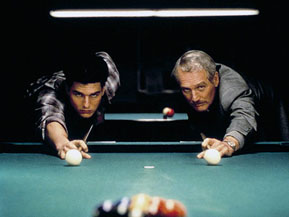Chapter Two: The Color of Money
By Brett Beach
May 12, 2011
Even in black and white, Newman’s startling baby blue eyes electrify in what is at heart a tale of someone who, to paraphrase another Best Picture nominee, is a character but doesn’t yet have character. The Hustler is the story of how he gains that attribute, at the ultimate expense of his livelihood. Filmed mostly indoors for the first half, the better to exploit the claustrophobic feeling of being inside a pool hall for hours on end, with daylight (and real life) kept at bay behind shuttered blinds, The Hustler at times feels like the adaptation of a stage play. While I don’t count myself as a fan of Tennessee Williams’ work, a familiarity with his style and the knowledge that Newman had starred in multiple adaptations of his works makes it easier for me to see The Hustler as a variation of sorts on the Southern Gothic genre. Call it Northern gothic. Nothing particularly grotesque happens, but there is a sense of all sorts of depravities and excesses lurking of in the wing. By the time the weak climax rolls around, what has been mostly underplayed and covert, to great effect, is spelled out in dialogue that sounds a little too forced and explanatory and stagy.
Newman may have the title role, but an also-nominated ensemble surrounds him and they all contribute to the film’s atmosphere of desperation. George C. Scott, in one of his earliest feature films, is all oily charm (in the first half) and banal evil (in the second half) as Felson’s bankroller, a gambler with all the luck until his veneer finally cracks at the end. Piper Laurie (in her last feature film for nearly 15 years) begins by toying with Felson, only to fall into a relationship and then love, and is tragically forced to confront the limitations of what she and Felson can truly feel for one another. And as Fats, Jackie Gleason provides definitive proof of why comedic actors can sometimes be the best choice for deeply dramatic roles. Wearing the air of a disinterested god, a being so good at the sport of pool, he is doomed to an endless ritual of fending off challenges from the young Turks who would snatch his crown, Gleason’s visage is as immutable as stone, and yet no less tragic for being so unreadable.
Why did it take so long for The Hustler to inspire a sequel? Simply put, because it took The Hustler author Walter Tevis 25 years to write the book sequel, which was published in 1984. (It should be noted, strangely enough, that the movie adaptation shares the book’s name but bears virtually no resemblance to that story, which picks up on Felson in middle age, and sets him off against Minnesota Fats on an oldies circuit.) As with the quick turnaround with The Hustler’s transformation from printed page to celluloid, The Color of Money only took two years to grace the big screen, debuting in October 1986.
It was a modest-sized hit, grossing about $53 million and spending five weeks at #2 (all of them behind the year’s second-biggest hit, Crocodile Dundee). Part of that popularity can be accorded to the presence of Tom Cruise in the film. Top Gun was still in the midst of its year-long assault on the box office - and the beginning of a lifelong assault on sensibilities such as mine - which would ultimately help it beat out its Paramount mate by less than $3 million to become the year’s highest grosser.
Continued:
1
2
3
|
|
|
|




